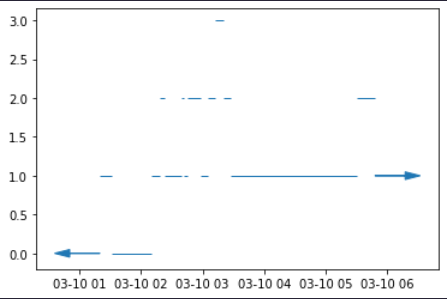I have the following table:
id | number_of _trip | start_date | end_date | seconds
1 637hui 2022-03-10 01:20:00 2022-03-10 01:32:00 720
2 384nfj 2022-03-10 02:18:00 2022-03-10 02:42:00 1440
3 102fiu 2022-03-10 02:10:00 2022-03-10 02:23:00 780
4 948pvc 2022-03-10 02:40:00 2022-03-10 03:20:00 2400
5 473mds 2022-03-10 02:45:00 2022-03-10 02:58:00 780
6 103fkd 2022-03-10 03:05:00 2022-03-10 03:28:00 1380
7 905783 2022-03-10 03:12:00 null 0
8 498wsq 2022-03-10 05:30:00 2022-03-10 05:48:00 1080
I want to get the time that is driven for each hour, but if a trip takes the space of two hours, the time must be taken for each hour.
If the end of the trip has not yet finished, the end_date field is null, but it must count the time it is taking in the respective hours from start_date.
I have the following query:
SELECT time_bucket(bucket_width := INTERVAL '1 hour',ts := start_date, "offset" := '0 minutes') AS init_date,
sum(seconds) as seconds
FROM trips
WHERE start_date >= '2022-03-10 01:00:00' AND start_date <= '2022-03-10 06:00:00'
GROUP BY init_date
ORDER BY init_date;
The result is:
| init_date | seconds
2022-03-10 01:00:00 720
2022-03-10 02:00:00 5400
2022-03-10 03:00:00 1380
2022-03-10 05:00:00 1080
However I expect to receive a result like this:
| init_date | seconds solo como una ayuda visual
2022-03-10 01:00:00 720 id(1:720)
2022-03-10 02:00:00 4200 id(2: 1440 3: 780 4: 1200 5: 780)
2022-03-10 03:00:00 5460 id(4:1200 6:1380 7:2880)
2022-03-10 05:00:00 1080 id(8:1080)
EDIT
If I replace the null the result is still unwanted:
| init_date | seconds
2022-03-10 01:00:00 720
2022-03-10 02:00:00 5400
2022-03-10 03:00:00 1380
2022-03-10 05:00:00 1080
I have been thinking about getting all the data and solving the problem with pandas. I'll try and post if I get the answer. EDIT
My previous result was not entirely correct, since there were hours left of a trip that has not yet finished, the correct result should be:
start_date seconds
0 2022-03-10 01:00:00 720
1 2022-03-10 02:00:00 4200
2 2022-03-10 03:00:00 5460
3 2022-03-10 04:00:00 3600
4 2022-03-10 05:00:00 4680
NEW CODE
def bucket_count(bucket, data):
result = pd.DataFrame()
list_r = []
for row_bucket in bucket.to_dict('records'):
inicio = row_bucket['start_date']
fin = row_bucket['end_date']
df = data[
(inicio <= data['end_date']) & (inicio <= fin) & (data['start_date'] <= fin) & (data['start_date'] <= data['end_date'])
]
df_dict = df.to_dict('records')
for row in df_dict:
seconds = 0
if row['start_date'] >= inicio and fin >= row['end_date']:
seconds = (row['end_date'] - row['start_date']).total_seconds()
elif row['start_date'] <= inicio <= row['end_date'] <= fin:
seconds = (row['end_date'] - inicio).total_seconds()
elif inicio <= row['start_date'] <= fin <= row['end_date']:
seconds = (fin - row['start_date']).total_seconds()
elif row['start_date'] < inicio and fin < row['end_date']:
seconds = (fin - inicio).total_seconds()
row['start_date'] = inicio
row['end_date'] = fin
row['seconds'] = seconds
list_r.append(row)
result = pd.DataFrame(list_r)
return result.groupby(['start_date'])["seconds"].apply(lambda x: x.astype(int).sum()).reset_index()


timescaledb- so it's PostgreSQL. – Riti